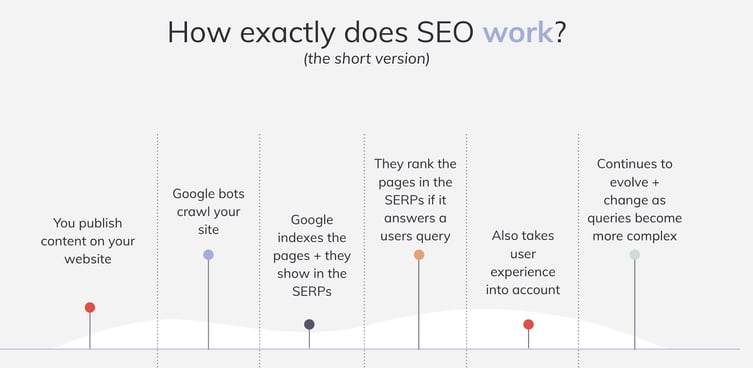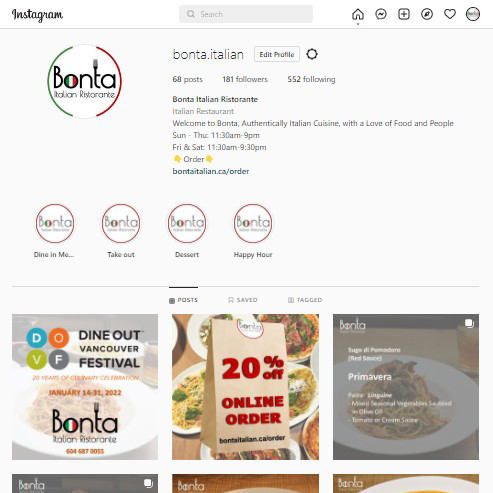Why Your Nonprofit Should Invest in Search Engine Optimization
Every company needs a strong marketing strategy — even nonprofits.
However, most nonprofits haven’t considered investing in search engine optimization (SEO), even though it can have one of the highest returns on investment.
SEO, specifically for nonprofits, is the process of optimizing your website to increase organic visibility when people search for topics like education, fundraising opportunities, volunteer opportunities, or other aspects that promote your mission.
Let’s dive into what SEO is, how it works, and SEO best practices for nonprofits.
What is SEO?
SEO, which stands for search engine optimization, is the process of driving users to your site from search engines organically. This means you aren’t paying for ads, using social media, or placing sponsored content to attract new users.
The goal of SEO is to help your site rank as high as possible for target keywords and phrases relevant to your website and mission.
For example, if your nonprofit is geared towards wildlife conservation, you would want to rank high organically for terms related to wildlife conservation. The higher your website or pages rank in the search engine result pages (SERPs), the more likely users will see it and click on it. Studies have shown that the higher you rank, the higher the average click-through-rate (CTR) is.
If you’d like a full rundown on SEO, take a look at The Ultimate Guide to SEO in 2022.
How does SEO work?

There are hundreds of factors that Google and other search engines take into account when ranking your site or content. These factors come from the three different pillars of SEO which are the following:
- Technical optimization
- On-page optimization
- Off-page optimization
Search engines are powered by people when they have a query and search for answers. Search engines use algorithms that decide what content and websites best fit the answer for the query. There are three steps that search engines take when assessing a site: crawling the site, indexing the site, and lastly, ranking the site.
Crawling, also known as the discovery stage, occurs first, then search engines decide if the pages should be indexed or shared on the search engine result pages and available for users to see and find. Lastly, the algorithm ranks the content in the search results, which is how users find your website or web page.
SEO for Nonprofits
So why should nonprofits invest in SEO? Well, SEO is just as important for nonprofits as it is for other companies. It is an affordable and effective long-term marketing strategy.
Investments you make in SEO today may take a while to pay-off, but they will continue to do so for years to come. SEO can take awhile to see the results due several factors, such as keyword difficulty, competition, domain age, and to trust of search engines and users. In general, it can take four to six months to see some movement in rankings and site health.
Increasing organic visibility of your nonprofit also increases the visibility of the mission you stand for while growing your brand awareness. Using SEO will help your pages move up in search engine rankings, creating a higher click-through-rate, more impressions, and overall, more traffic.
How to Measure SEO Success
Depending on your goals and what you want to accomplish, there may be multiple aspects you’d like to measure and evaluate for success, such as:
- Keywords
- Organic traffic
- Market share compared to competitors
- Conversions
- Backlinks
- Page rankings
Some goals for your nonprofit might include having more priority keywords move into the top 10 positions, increasing organic traffic on specific pages, or increasing organic conversions.
SEO Best Practices for Nonprofits
If you’re confused or intimidated by the idea of becoming discoverable online and creating a successful SEO strategy, we’ve got you covered.
Here are the five best SEO practices to focus on for your nonprofit this year.
1. Keyword research should create your content strategy.
It’s important to know what your prospective and ideal customers are searching for and what their journey is. Search engine rankings are determined by algorithms that use quite a few factors to decide how well a webpage answers a query.
Unfortunately, it’s not as easy as throwing keywords into your content, so here are a few things to consider.
Search Intent
A query or keyword can have multiple meanings depending on the person or where they are in the user journey. They might be looking for more information, directions, or to make a purchase or donation, and each of those actions would need a different query. It’s important to make sure that the right keyword goes with the right piece of content.
Relevant Keywords
If you’re a nonprofit that works with homeless communities, a long-tail keyword you might want to focus on could be “how to help homeless communities”. Knowing this, you can create content and resources that will drive users to your site. You should avoid keywords that don’t truly represent your brand or what you offer.
Long-tail keywords are keywords or phrases that are more specific, and usually longer than common keywords. An example of a long-tail keyword might be “light blue beach hat” and a short-tail keyword would be “hat” or “beach hat”. Shorter-tailed keywords are usually harder to rank for, but have more traffic. Longer-tailed keywords have less traffic but a higher conversion rate, which is ideal for most nonprofits.
Additional thoughts:
- It can often be easier to target long-tail keywords (a phrase vs. a one-word term), which drive more qualified traffic
- There are different keywords targeting users at each part of the sales funnel
- Keyword research takes time and evolves as well
Google offers a great free keyword research tool that can also be used for SEO. If you’re looking for a more SEO specific platform, MOZ and SEMRush are two great platforms that both offer nonprofit pricing.
2. Create high-quality content.
Content will always be one of the most important ranking factors. Not only is it essential to have SEO-optimized content, but the quality is important, as well. Google wants to ensure that you’re publishing content that follows their E-A-T standards.
The concept of E-A-T, which stands for expertise, authoritativeness, and trustworthiness, is considered an SEO best practice when creating content. These factors help Google avoid sharing and feeding inaccurate or misleading information. You can follow these factors from Google by:
- Updating old content to make sure it’s relevant
- Ensuring the content is accurate
- Allowing experts or other writers to create content for you
Along with E-A-T, make sure that your content follows the best on-page practices. This includes focusing on a primary keyword, adding metadata, using proper headings, adding alternative text (ALT text) to your image, and using internal linking, to name a few.
3. Make sure your site is mobile-friendly.
A majority of users across all industries use their phones instead of desktop computers as of 2022.
Additionally, Google crawls sites using a Google phone bot to make sure your site is mobile-friendly. This means your site is able to shrink down and fit on any screen while still allowing users to access your content as easily as on a desktop.
Mobile-friendliness is a ranking signal in both Google and Bing’s algorithms when a user is searching on a mobile device. If your website is mobile-friendly, it generally will outrank non-mobile-friendly sites.
There are several tools available to test you website’s mobile-friendliness:

Google’s results via Page Speed Insights
4. Link-building is crucial to create brand awareness.
Nonprofits can struggle with getting donations due to lack of overall brand awareness and organic visibility. Link-building relies on creating authoritative content that other sites will want to link share with and link back to. A great example of this is allowing your annual reports to be sharable for others to see.
One strategy to consider would be to reach out to partners or sponsors and see if they will link back to you on their site and in their content. This is especially important for pages you want to drive traffic to.
5. Local SEO is very relative for most nonprofits.
Local SEO is very beneficial for nonprofits because it can help bring people to a fundraising event or even attract volunteers. For example, if you search “food drive near me” on Google, local listings will pop up. This is because they have focused on a local SEO strategy by utilizing their Google Business Profile.
Google Business Profile allows you to gather reviews, add images and videos, and ensure that your information is up to date for users. You can also add FAQs with answers for users to see as well. All of this helps organizations land on the top of Google listings for this query.
Nonprofit SEO Case Study
Finally, let’s explore how two nonprofits — diaTribe and CreakyJoints — excelled using SEO.
First, diaTribe, a diabetes organization that aims at providing education and resources for those living with diabetes, leveraged an SEO strategy to reach new audiences during the pandemic.
The nonprofit focused on keywords that had low competition, and we helped the organization capitalize on highly-relevant topics based on keyword research data.
As a result, the organization hit all their website traffic and subscriber goals — helping grow their email list by 28% and their website traffic 15% year-over-year.
Next, Media Cause started working with CreakyJoints, a leading support, education, advocacy, and research organization for people living with arthritis and rheumatic disease, in August 2018 to increase organic search traffic.
By monitoring and resolving SEO-related issues, optimizing existing pages for Google search crawlers, and providing content recommendations based on keyword research, we helped CreakyJoints quadruple their monthly search traffic after just five months.
Today, CreakyJoints’ content is reaching 4x the number of people it used to. That means more people living with arthritis and chronic pain are learning how to navigate their patient journey better, including learning about the long-term effects of their medications, safe and effective ways to manage their symptoms, and how to lead healthy and empowered lives thanks to CreakyJoints.
Investing in an SEO strategy and working on it over time will pay off immensely for your nonprofit in the long run, and it’s cost-effective. While it may take up to six months, you’ll see an increase in your organic and qualified traffic that will help increase visibility for your mission and create better engagement.
By implementing the tips above or working with an agency that is dedicated to promoting your mission, you’ll convert users and help drive them to you.
![]()
![Download Now: Nonprofit Marketing & Fundraising Trends for 2022 [Free Report]](https://no-cache.hubspot.com/cta/default/53/6193b715-2ba9-4c6d-add0-681edfcae689.png)



























